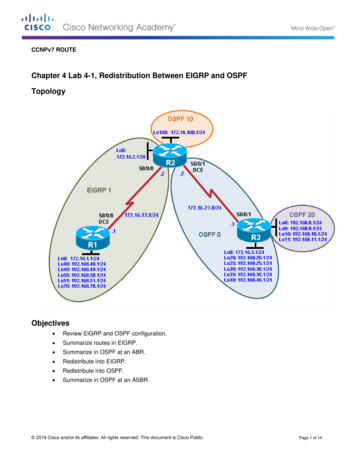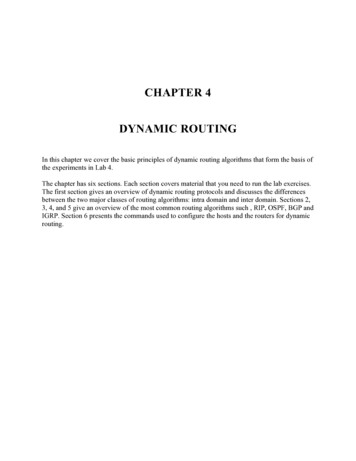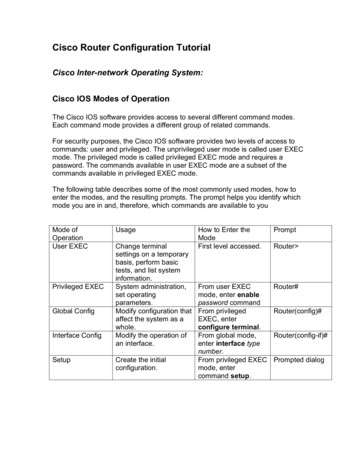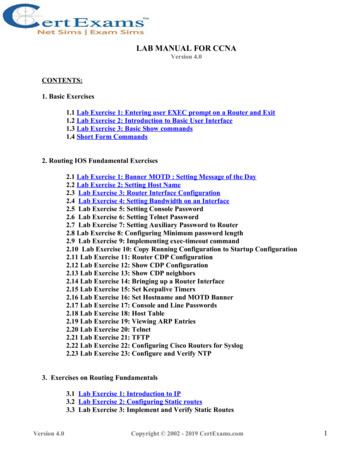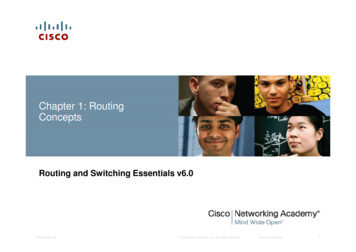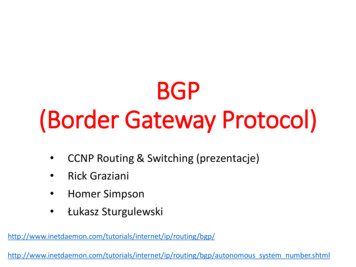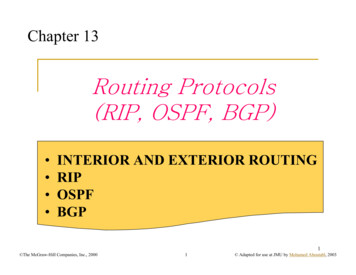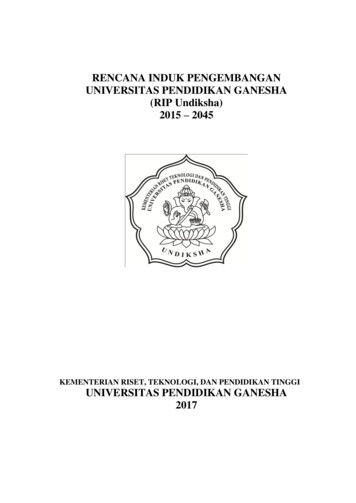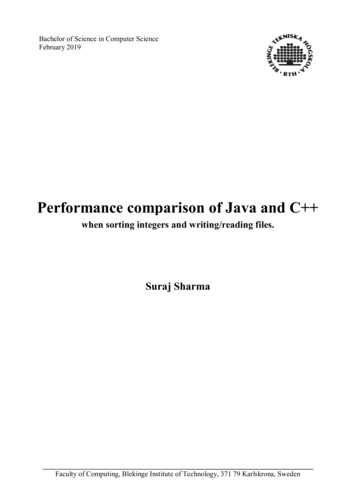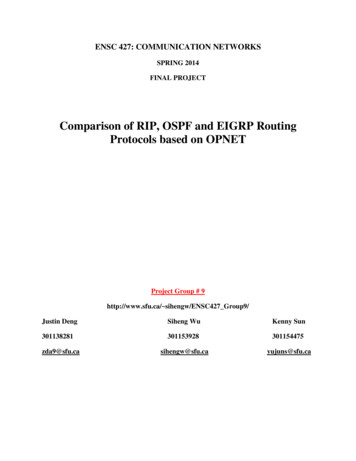
Transcription
ENSC 427: COMMUNICATION NETWORKSSPRING 2014FINAL PROJECTComparison of RIP, OSPF and EIGRP RoutingProtocols based on OPNETProject Group # 9http://www.sfu.ca/ sihengw/ENSC427 Group9/Justin DengSiheng WuKenny @sfu.cazda9@sfu.ca
Table of ContentsList of Figures . . .1Abstract.21. Introduction.31.1 Routing Protocol Basics . . . .31.2 Routing Metrics Basics . . . . .31.3 Static Routing and Dynamic Routing .31.4 Distance Vector and Link State .32. Three Routing Protocols . . .42.1 Routing Information Protocol (RIP) . . .42.2 Open Shortest Path First (OSPF) . . . .52.3 Enhanced Interior Gateway Routing Protocol (EIGRP) . .73. OPNET Simulations .83.1 Topologies . .83.1.1 Mesh Topology . . .83.1.2 Tree Topology . .93.2 Simulation Setup .103.2.1 Simulation Setup for Failure/Recovery Configuration. .103.2.2 Simulation Setup for Individual DES statics . . 103.2.3 Simulation Setup for Simulation Global Attributes. .113.2.4 Model Attributes .124. Result and Analysis .145. Conclusion . . .205.1 Future work and difficulties .21References . 22
List of FiguresFigure.1 Simple structure of OSPF .5Figure.2 Shortest path tree. .6Figure.3 Area. .6Figure.4 Basic structure of Mesh topology. .9Figure.5 Basic structure of Tree topology. .9Figure.6 Failure/Recovery Configuration. .10Figure.7 RIP DES statics .10Figure.8 OSPF DES statics. .11Figure.9 EIGRP DES statics . .11Figure.10 Simulation Global Attributes. .12Figure.11 Simulation Global Attributes. 12Figure.12 RIP parameters. .12Figure.13 OSPF parameters . .13Figure.14 EIGRP parameters . .14Figure.15 Overlaid Convergence Activity on small mesh. .15Figure.16 Overlaid Convergence Activity on mesh .15Figure.17 Overlaid Convergence Activity on tree. .16Figure.18 Overlaid Convergence Activity on tree. .17Figure.19 OSPF Average Convergence Duration over different topologies. .17Figure.20 EIGRP Average Convergence Duration over different topologies. 18Figure.21 Traffic sent comparison on small mesh topology. .18Figure.22 Traffic sent comparison on mesh topology. . .19Figure.23 Traffic sent comparison on tree topology . .201
AbstractIn a computer network, the transmission of data is based on the routing protocol which selectsthe best routes between any two nodes. Different types of routing protocols are applied tospecific network environment. Three typical types of routing protocol are chosen as thesimulation samples: RIP, OSPF and EIGRP. RIP (Routing Information Protocol) is one of theoldest routing protocols still in service. Hop count is the metric that RIP uses and the hop limitlimits the network size that RIP can support. OSPF (Open Shortest Path First) is the most widelyused IGP (Interior Gateway Protocol) large enterprise networks. OSPF is based on the ShortestPath First (SPF) algorithm which is used to calculate the shortest path to each node. EIGRPEnhanced Interior Gateway Routing Protocol) is Cisco's proprietary routing protocol based onDiffusing Update Algorithm. EIGRP has the fastest router convergence among the threeprotocols we are testing.More detailed description of these three routing protocols will be included later. We aim toanalyze the performance of the three protocols such as their router convergence, convergenceduration and end-to-end delay. In our project, we are going to use OPNET to simulate RIP,OSPF and EIGRP in order to compare their attributes and performance. According to theconvergence we can find out which protocols are suitable for different sizes and types of network.2
1. Introduction1.1 Routing Protocol BasicsA routing protocol is the language a router speaks with other routers in order to shareinformation about the reachability and status of network.(1) It includes a procedure to selectthe best path based on the reachability information it has and for recording this informationin a route table. Regarding to select the best path, a routing metric will be applied and it iscomputed by a routing algorithm.1.2 Routing Metric BasicsA metric is a variable assigned to routers as a means of ranking them from the best to worstor from most preferred to least preferred. (1) Different routing protocols have differentmetrics. When there is more than one route between two nodes, a router must determine amethod of metrics by choose the routing protocol to calculate the best path.1.3 Static Routing Dynamic RoutingProtocols can fall into two groups: static routing and dynamic routing. Static routing issimply the process of manually entering routes into a device‟s routing table via aconfiguration file that is loaded when the routing device starts up. In static routing, all thechanges in the logical network layout need to be manually done by the system administrator.However, dynamic routing allows routers to select the best path when there is a real timelogical network layout change. In our project, we will discuss the difference between theEIGRP, RIP and OSPF. All of them are belong to dynamic routing protocols.1.4 Distance Vector and Link StateIn addition, most routing protocols can be classified into two classes: distance vector and linkstate. Distance vector routing protocol is based on Bellman – Ford algorithm and Ford –Fulkerson algorithm to calculate paths. A distance vector routing protocol uses a distancecalculation and a vector direction of next hop router as reported by neighboring routers tochoose the best path. It requires that a router informs its neighbors of topology changesperiodically.Link state routing protocols build a complete topology of the entire network are and thencalculating the best path from this topology of all the interconnected networks. It requiresmore processing power and memory because it has a complete picture of the network.3
2. Three Routing Protocols2.1 Routing Information Protocol (RIP)RIP is a standardized vector distance routing protocol and uses a form of distance as hop count metric.It is a distance vector. Through limiting the number of hop counts allowed in paths between sourcesand destinations, RIP prevents routing loops. Typically, the maximum number of hops allowed forRIP is 15. However, by achieving this routing loop prevention, the size of supporting networks issacrificed. Since the maximum number of hop counts allowed for RIP is 15, as long as the numbergoes beyond 15, the route will be considered as unreachable.When first developed, RIP only transmitted full updates every 30 seconds. In the early distributions,traffic was not important because the routing tables were small enough. As networks become larger,massive traffic burst becomes more likely during the 30 seconds period, even if the routers had beeninitialized at different times. Because of this random initialization, it is commonly understood that therouting updates would spread out in time, but that is not the case in real practice.RIP has four basic timers:Update Timer (default 30 seconds): defines how often the router will send out a routing table update.Invalid Timer (default 180 seconds): indicates how long a route will remain in a routing table beforebeing marked as invalid, if no new updates are heard about this route. The invalid timer will be resetif an update is received for that particular route before the timer expires. A route marked as invalid isnot immediately removed from the routing table. Instead, the route is marked with a metric of 16,which means the route is unreachable, and will be placed in a hold-down state.Hold-down Timer (default 180 seconds): specifies how long RIP will keep a route from receivingupdates when it is in a hold-down state. In a hold-down state, RIP will not receive any new updatesfor routes until the hold-down timer expires. A route will go into a hold-down state for the followingreasons: The invalid timer has expired An update has been received from another router; route goes into a 16 metric (or unreachable). An update has been received from another router; route goes into a higher metric than what it iscurrently using.Flush Timer (default 240 seconds): When no new updates are received about this route, flush timerindicates how long a route can remain in a routing table before getting flushed out. The flush timersoperates simultaneously with the invalid timer, so every 60 seconds, after it has been marked invalid,the route will get flushed out. When RIP timer is not in sync with all routers on the RIP network,system instability occurs. This timer must be set to a higher value than the invalid timer.4
2.2 Open Shortest Path First (OSPF)OSPF is defined in RFC 2328 which is an interior Gateway Protocol used to distributerouting information within an AS (Autonomous System). Among all the three chosensamples, OSPF is the most widely used routing protocol in large enterprise networks. OSPFis based on link-state technology by using SPF algorithm which calculates the shortest path.SPF calculationBefore running the calculation, it is required that all routers in the network to know about allthe other routers in the same network and the links among them. The next step is to calculatethe shortest path between each single router. For all the routers they exchange link-stateswhich would be stored in the link-state database. Every time a router receives a link-stateupdate, the information stores into the database and this router propagate the updatedinformation to all the other routers. Below is a simple model of how the SPF algorithm works.Figure 1: Simple structure of OSPFA simple network formed by five routers; all the routers know about all the other routers andlinks. After all the paths are figured out, the path information are stored in the link database.The link database for the above model is : [A, B, 3], [A, C, 6], [B, A, 3], [B, D, 3], [B, E, 5],[C, A, 6], [C, D, 9], [D, C, 9], [D, B, 3], [D, E, 3] , [E, B, 5] and [E, D, 3]. Each term isreferred to the originating router, the router connected to and the cost of the link between thetwo routers. Once the database of each router is finished, the router determines the ShortestPath Tree to all the destinations. (The shortest path in the SPF algorithm is called theShortest Path Tree). The Dijkstra Shortest Path First is then running to determine the shortestpath from a specific router to all the other routers in the network. Each router is put at theroot of the Shortest Path Tree and then the shortest path to each destination is calculated. Theaccumulated cost to reach the destination would be the shortest path.5
The cost (metric) of OSPF is the cost of sending packets across a certain interface. Theformula to calcite the cost is: cost 10000 0000 /bandwidth in bps. If the bandwidth is wider,the cost would be lower.Below is a diagram of the structure used to calculate the Shortest Path Tree.Figure 2: Shortest path treeWhen the Shortest Path Tree is completed, the router will work on the routing table.Areas and Border RoutersIn OSPF protocol, an Autonomous System can be divided into sections. A section and anearby router can dorm an AREA. Since each section calculate the Shortest Path using thesame algorithm as above, each section has its own database and path tree and the informationare invisible outside this section. By doing this, the size of the database can be dramaticallyreduced.Figure 3: Area6
In an autonomous, there is a backbone called Area 0 which is the pivot of this autonomous.Area 0 connected to other sections with ABR (Area Border Router) to exchange link-state.Stub Area, Not-So-Stubby Area, Totally Stubby Areas and Totally NSSA are other types ofsections with specific functions.AdvantagesCompare to RIP, OSPF has no limitation due to hops (RIP has a limit of 15 hops so anynetwork with more than 15 hops cannot be achieved by RIP. OSPF can handle VariableLength Subnet Masks (VLSM) but RIP cannot. The most important is that OSPF convergesmuch faster than RIP due to its calculation algorithm. This might not be significant in a smallsize network but in large enterprise networks, this will be a time out.2.3 Enhanced Interior Gateway Routing Protocol (EIGRP)The Enhanced Interior Gateway Routing Protocol (EIGRP) is a hybrid routing protocolwhich provides significant improvements on IGRP. EIGRP replaced IGRP in 1993 sinceInternet Protocol is designed to support IPv4 addresses that IGRP could not support. Hybridrouting protocol incorporates advantages of both Link-state and Distance-Vector routingprotocols, it was based on Distance-Vector protocol but contains more features of Link-Stateprotocol. EIGRP saves all routes rather than the best route to ensure the faster convergence.EIGRP keeps neighboring routing tables and it only exchange information that it neighborwould not contain. EIGRP is commonly used in large networks, and it updates only when atopology changes but not periodically unlike old Distance-Vector protocols such as RIP.Metric is used to determine whether the chosen route is optimized. EIGRP metric is based onits bandwidth, delay, reliability, load and MTU. A default expression for EIGRP metricis 𝑀𝑒𝑡𝑟𝑖𝑐 𝐵𝑎𝑛𝑑𝑊𝑖𝑑𝑡ℎ 𝐷𝑒𝑙𝑎𝑦 256.There are four basic components to operate EIGRP, which are Neighbour Discovery/RecoveryReliable Transport ProtocolDUAL Finite State MachineProtocol Dependent ModuleSince EIGRP updates are triggered when there is a change, it is important to have a processthat routers dynamically learn of other routers on directly connected network. A routershould discover once a neighbouring router is unreachable of inoperative. NeighbourDiscovery and Recovery is accomplished by sending small Hello packets periodically at lowcost. Once the hello packets are received, whether this neighbour is alive can be determined.The neighbouring router will start exchanging information when routers are functioning.The default EIGRP algorithm DUAL requires guaranteed and ordered delivery of packets fortransmission which reliable transport protocol manages. EIGRP sends a unicast data receiver7
indicating the hello packet does not require the confirmation of the notification packet. Whenthere is a packet sending, a sequence number is assigned which is incremented by the routersending a new packet. Reliable Transport Protocol insures fast transport when there areunacknowledged packets pending. That guarantees the low convergence time.DUAL, the Diffusing Update Algorithm is the default convergence algorithm which is usedin EIGRP to prevent routing loops from recalculating routes. DUAL tracks all routes anddetect the optimal path in terms of efficiency and cost which will be added in the routingtable. There also exist backup routes that can be used in case the optimal route is dropped.Protocol Dependent Modules are used to encapsulate the IP packets for network layer. Itdetermines if an additional route is necessary from sources such as routing table. PDMs makesure that EIGRP provides support for various routed protocols.3. OPNET Simulations3.1 TopologiesNetwork topology is the arrangement of various elements of a computer network. It istypically described as either physical or logical. Different placements of network componentssuch as device location and the shape of cabling layout are part of physical topology. On theother hand, Logical topology illustrates how the data passes through the network regardlessof the physical design. In many cases, network topologies may be identical, but the distancesbetween nodes, physical interconnections, transmission rates and signal types will still bedifferent. We use two basic topologies in our project, which are mesh and tree topology.3.1.1 Mesh TopologyIn mesh topology, each node distributes data in the network, and the value of a fully meshednetwork is proportional to the exponent of the number of subscribers. This relationship ismodeled by Reed‟s Law. In a fully connected network, each of the nodes is connected toeach other, making a complete graph. Therefore a fully connected network does not requirethe usage of any switching nor broadcasting. Nonetheless, this network becomes particularlyimpractical in larger networks, as the numbers of connections grow quadratically with thenumber of nodes, by the formulaand so it is extremely impractical for largenetworks. A two-node network is technically a fully connected network. Figure 4 representsthe structure of Mesh topology we used in this project.8
Figure 4: Basic structure of Mesh topology3.1.2 Tree TopologyIn a tree network topology, nodes are arranged in a form of hierarchy where the highest levelconsists of a single „root node‟. From this root node, it branches out through point-to-pointlinks into single or multiple nodes in the next level. This process repeats at each level, andthere are no limits to the number of levels within a network. Each node in the network has aspecific number of nodes to connected, and this number is referred to as the „branchingfactor‟. On the other hand, as a bus network topology variant, tree topology is especiallyprone to crippling network failures. Figure 5 represents the structure of Tree topology weused in this project.Figure 5: Basic structure of Tree topology9
3.2 Simulation Setup3.2.1 Simulation Setup for Failure/Recovery ConfigurationFigure 6 below shows the setup for Recovery Configuration. The simulation is set to be15 minutes, the first failure is set to be 5 minutes which is 300 second, and the recovery isset to be 600 seconds. Recovery configuration is set to be the same for all scenariosexcept the route would be dropped.Figure 6: Failure/Recovery Configuration3.2.2 Simulation Setup for Individual DES staticsSince three protocols will be examined, the individual statics will be set differently. Itconcludes the features will be compared in the project which are Convergence Activity,Convergence Duration and Traffic Sent (bits/sec).Figure 7: RIP DES statics10
Figure 8: OSPF DES staticsFigure 9: EIGRP DES statics3.2.3 Simulation Setup for Simulation Global AttributesIP dynamic Routing Protocol is set to be RIP, OSPF and EIGRP respectively. And itexports routing table once the simulation is completed. Simulation efficiency for threeprotocols are disabled and stop time has been set to longer than the simulation time, itguarantees the protocols continue throughput until the end of the simulation.11
Figure 10: Simulation Global AttributesFigure 11: Simulation Efficiency setup3.2.4 Model AttributesFigure 12: RIP parameters12
-------The RIP routing tables are initialized with the local gateway‟s IP addresses. The costfor these routes is set to 0.Silent RIP processes are modeled with a parameter that can be controlled by the user.Silent RIP processes do not send out routing update messages, and are normally usedfor hosts that do not act as network gateways.The start time at which the first regular routing updates are generated is a parameterthat can be controlled by the user.Split Horizon with Poisoned Reverse is implemented to avoid including routes inupdates sent to the gateway from which they were learned. Such routes are includedin updates, but their metrics are set to infinity.Regular and Triggered UpdatesGarbage Collection (Flush) and Timeout (Route Invalid) timersFigure 13: OSPF parametersHello interval: Time between Hello packets sent by the router on this interface. Thisvalue should be same for all interfaces connected to common network. The defaultvalue is 10 seconds.Router Dead Interval: Time after which, if a neighboring router‟s Hello messages arenot seen, it is considered inactive. It should typically be set to some multiple of theHello Interval, and should be the same for all interfaces attached to a commonnetwork. The default value is 40 seconds.Interface Transmission Delay: The estimated time it takes to transmit a link stateadvertisement (LSA) packet over this interface. This value is used to age an LSAprior to transmission on an interface. The default value is 1 second.Retransmission Interval: Time (in seconds) between LSA retransmissions foradjacencies belonging to this interface. The default value is 5 seconds.13
---Figure 14: EIGRP parametersHello Interval. Determines the time interval between hello messages. A high valuelowers the EIGRP traffic in steady state, and a low value enables node failures to bedetected more quickly.Hold Time. Specifies the value of hold time, which is advertised in the hello messagesent over the corresponding IP interface. The hold time value defines the amount oftime a neighbor should wait for another hello message from this process model beforemarking its node as down. A high hold time value delays the detection of nodefailures, and a low value may cause misjudging the status of a neighbor as downbecause of a few delayed or dropped hello packets.Split Horizon. Enables or disables split horizon on the interface. The defaultconfiguration enables this feature on all interfaces.Route Filters. Specifies the prefix/distribute lists used to filter routes received on orsent from this interface. Prefix/distribute lists are defined in the IP IP RoutingParameters Prefix Filter Configuration attribute.4. Result and AnalysisBased on our three topologies, we simulated the performance of each routing protocol on allthree topologies.Firstly we ran the simulation on small mesh topology for RIP, OSPF and EIGRP.14
Figure 15: Overlaid Convergence Activity on small meshThe three peaks from left to right in the graph represent: initialization, failure, recover. Thewidth of the peak stands for the convergence time of the protocol. If the peak is wider, theprotocol converges slower. In small mesh topology, EIGRP is the fastest protocol among thethree. RIP is a little bit slower than EIGRP. It is clear to see from the graph that OSPFconverges most slowly.Next we simulated the data transmission of three protocols on large mesh topology.Figure 16: Overlaid Convergence Activity on mesh15
This time the fastest protocol is still EIGRP. OSPT has longer initialization and recover timethan the other two protocols. The difference in peak duration for OSPF is not significant insmall and large topologies. RIP is the slowest one in large mesh especially when the link isfailed; its initialization duration is half of OSPF. RIP has very long fail convergence compareto the other two. Our assumption was RIP is limited by its hop count which is only 15.Then we simulated the data transmission of large tree topology.Figure 17: Overlaid Convergence Activity on treeEIGRP is still the fastest protocol among all three. OSPF has a slightly longer initializationtime compare to RIP and both OSPF and RIP has much longer initialization time than EIGRP.The fail convergence time is different from the mesh topology where EIGRP OSPF RIP,but the difference is not significant. RIP has the longest recover time and OSPF is a bit faster.16
Figure 18: RIP Average Convergence Duration over different topologiesIt is clear to tell that RIP has best performance on small network comparing to large tree andmesh. Since RIP has to update every 30 seconds, it will take more time on large networks.Figure 19: OSPF Average Convergence Duration over different topologiesThe performance of OSPF is quite similar in three topologies. The initialization time in singemesh is a slightly faster than that in large mesh and large tree.17
Figure 20: EIGRP Average Convergence Duration over different topologiesFrom figure 20, it looks like a huge difference over topologies but in details, the difference isonly around 0.02 second which is really tiny. Therefore, the convergence of EIGRP indifferent topologies did not have radical improvement.Figure 21: Traffic sent comparison on small mesh topologyThe figure above shows the router traffic sent in bits/sec in three protocols using single meshtopology. From the graph, the first peak is the initial traffic, the next peak is link failure andthe last peak is the link recovery in the network. We can tell OSPF generates the highestinitial traffic since the OSPF will map out the network which requires routers to distribute a18
large amount of information then choosing a path. In addition, we note that EIGRP has thehighest bandwidth efficiency, and the second one is OSPF. However, the RIP has the lowestbandwidth efficiency. In this graph, the RIP shows a little difference from OSPF and EIGRPbecause RIP will update the routing table every 30 seconds, which is the same as our result.Figure 22: Traffic sent comparison on mesh topologyWhen we use large mesh topology, we can clearly tell that the throughput for each protocol hasincreased. It is just because the number of routers used in this topology is increased. At thebeginning, OSPF has a throughput of 0.52Mbps, but EIGPR only has 0.2 Mbps. As wementioned that OSPF using link state and EIGRP using hybrid in the introduction, link staterequires to map out the whole network at the beginning. Also, we note that when failure occursthe EIGRP has higher throughput than OSPF. However, when recovery occurs the throughput ishigher than EIGRP, which is the same situation as the initial. As for bandwidth efficiency, OSPFand EIGRP has a much higher bandwidth efficiency than RIP. In every 30 seconds, RIP wastesabout 0.11Mbps, so we think RIP is only suitable for small network.19
Figure 23: Traffic sent comparison on mesh topologyWhen we use large tree topology, we can clearly tell that at the beginning, OSPF has athroughput of 0.95Mbps, but EIGPR only has 0.18 Mbps. As we mentioned that OSPF using linkstate and EIGRP using hybrid in the introduction, link state requires to map out the wholenetwork at the beginning. However, when failure and recovery occurs the EIGRP has higherthroughput than OSPF. As for bandwidth efficiency, OSPF and EIGRP has a much higherbandwidth efficiency than RIP. In every 30 seconds, RIP wastes about 0.19 Mbps, so again weprove that RIP is not suitable for large network.5. ConclusionWe analyzed the performance of three major types of routing protocols: RIP, OSPF andEIGRP using OPNET. Three different topologies had been built and the simulation of eachrouting protocol in all three topologies had been performed. Firstly we implemented the threerouting protocols into a small mesh network and recorded the convergence activity,convergence duration and traffic sent (bytes/sec) to compare the difference in theirperformance. Then we implement the three protocols into large mesh and large treetopologies and recorded the same three graphs as we did in small mesh network.We first compare the simulation result of convergence activity of three protocols. We didboth horizontal and vertical comparisons. According to the convergence activity results, it isobviously that EIGRP is the fastest routing protocol among all the tree protocols when20
initializing, failing and recovering. OSPF is the slowest (OSPF has to let all the routers toknow each other) when initializing which matches our research. In small network, RIP‟sperformance is close to EIGRP but when we changed to large network, RIP‟s convergencespeed is the slowest. According to the traffic send (bytes/sec) we can conclude that OSPF andEIGRP benefit from the bandwidth while RIP sends complete information to flood thenetwork which wasted bandwidth.Refer to our analysis of all simulation results, we can conclude that EIGRP is the best choicefor both large and small networks since it has the fastest convergence and EIGRP uses thebandwidth efficiently. But our research showed that EIGRP had just been implemented tocompanies other than CISCO (2013), and the structure is complicated. Based on EIGRP‟sattributes, OSPF will be the second choice for large networks. RIP has the worst performancein large networks so it is suitable for small, simple networks.5.1 Future work and difficultiesIn the future, we should do some security analysis for RIP, OSPF and EIGRP. In addition, wecan implement different topologies in terms of the number of routers and links, distance andtopology type. In our project, we just analyzed for OSPFv2 and EIGRP in the IPv4environment based on OPNET. We should also compare OSPFv3 and EIGRP in the IPv6environment using OPNET.The first plan of the project was about VPN, but the topic has been changed since theexpected result could not be achieved. Therefore, the whole process of research, simulationsetups and report have to b started over. After reading a lot of paper and t
Enhanced Interior Gateway Routing Protocol) is Cisco's proprietary routing protocol based on Diffusing Update Algorithm. EIGRP has the fastest router convergence among the three protocols we are testing. More detailed description of these three routing protocols will be included later. We aim to
